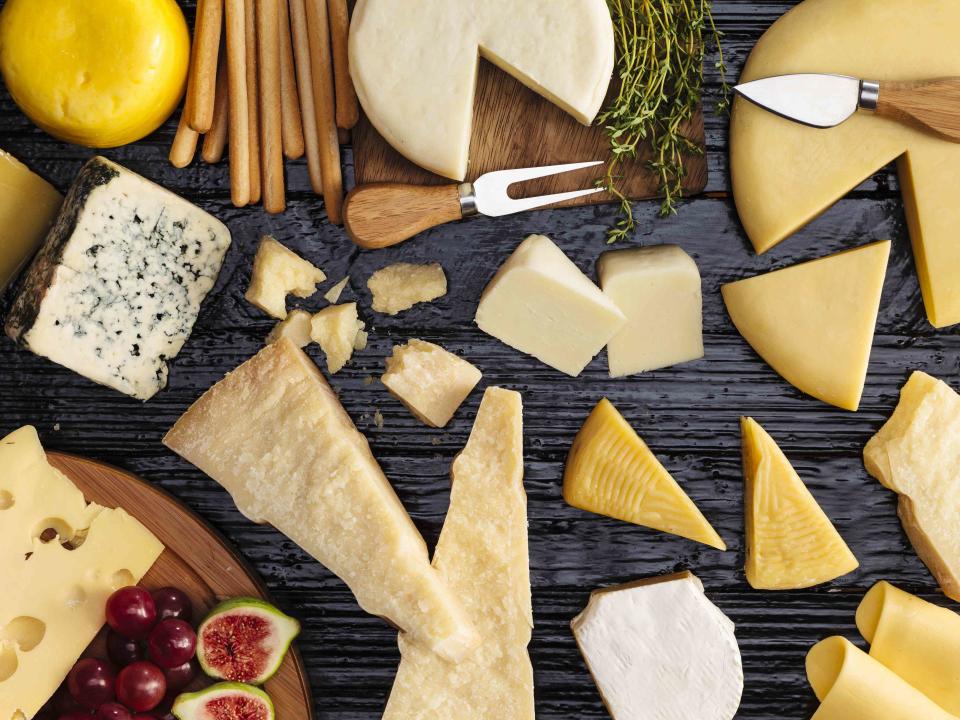What Is Rennet?
Everything you need to know about the enzyme responsible for cheese.

fcafotodigital/Getty Images
Cheese — so glorious a thing with unlimited uses and such a fanatic following, it may as well be its own food group. However, while consuming or purchasing this creamy delight, you're bound to wonder just how milk turns into cheese or what exactly that "r" word is on the ingredient list.
What Is Rennet?
Rennet is a natural substance, made up of enzymes (including one called rennin) from the fourth stomach of an unweaned mammal, most commonly cow, sheep, or goat. It must come from an animal that has yet to be weaned because once their diet switches from dairy to grass, the enzyme fades away and going to gather it would be all for not.
The vast majority of cheeses you find in the grocery store will contain some form of rennet, as it's essential to the process of converting milk to cheese. But just because this enzyme on the ingredient list doesn't mean it's ever intended for solo consumption. Rather, it’s just as a means to an end.
Related:25 of Our Ooiest, Gooiest, Cheesiest Recipes
The power of rennet in the cheesemaking process was likely discovered accidentally. In ancient times, milk was stored and transported in vessels made from animal stomachs, and with the inevitable exposure to heat and time in these stomachs, the milk was prone to separating into solid curds and liquid — the first step to cheese.
Cheesemaking: How It Works
Inside the stomach, rennin coagulates milk into solids, slowing down its digestion to allow the animal enough time to extract its nutrients. Once the milk-transporters of yesteryear witnessed this for themselves, they were off and running.
Related:13 Easy Homemade Cheese Recipes
On the road from milk to cheese, rennet is added to milk to mimic what happens in the stomach — coagulation to separate the milk's solids from its liquids. Milk solids are fat, casein protein, and minerals; these become what we know as curds. Its liquid contains water, whey protein, and lactose. This mixture is then heated, because the enzymes activate between 85 degrees F and 105 degrees F and will help coagulating the milk until it reaches 140 degrees F. How loose or firm the cheesemaker allows those curds to remain depends entirely on the type of cheese being made. Making Camembert? Leave 'em loose. Cheddar? They'll need to be firmer.
Varieties of Rennet
Today, rennet comes in many forms, and it doesn't always need to be taken from animals. Here are the types readily available for any cheesemaking need:
Animal Rennet
The original rennet harvested from the stomachs of young mammals can be purchased in liquid, paste, tablet, or powdered form — the latter two being fairly new inventions — allowing for longer storage in areas where it's warmer.
These forms of animal rennet are typically what is used, however, there are some independent cheese producers who are holding firm to old-school methods, utilizing strips of dried stomach in their process. Places that manufacture cheese steer clear of this practice from thousands of years ago because the new forms of rennet allow for a controlled potency and therefore, a predictable product. Not to mention, the FDA has a good grip on the regulation of animal rennet manufacturing and anything homemade wouldn't be up to snuff.
Plant Rennet
Surprisingly, a form of renin can be found in some plants, like artichokes, nettles, and cardoon thistle. (Familiar? Me neither.) This is a great alternative to create a vegetarian-friendly cheese and is even the traditional choice of cheesemakers in certain geographical areas — Spain and Portugal to name a couple.
Related:Here's Why Not All Cheese Is Vegetarian Friendly
Vegetarian rennet can also be created in a lab, derived from mushrooms and in this case, might be labeled as microbial rennet.
Because rennet has no taste, you won't be able to tell a difference between that made with the animal product versus the plant stuff, but you will notice there's no plant-made cheese aged beyond six months. This is because the enzyme from plants can impart bitterness if aged for too long. Aged cheeses with microbial rennet can give off a slight mushroom-y flavor as well. In short, if the cheese is being aged, animal it is.
Mold
Some makers opt for a type of mold called mucur miehei to mimic milk's response to rennet. It yields results without leaving mold in the final product.
Cheeses Made Without Rennet
Some softer, "fresh" cheeses like ricotta, cream cheese, and paneer don't contain rennet. They don't need it, being that their coagulation is made possible with the addition of acid — most commonly vinegar, citric acid, or even the milk's own lactic acid.

